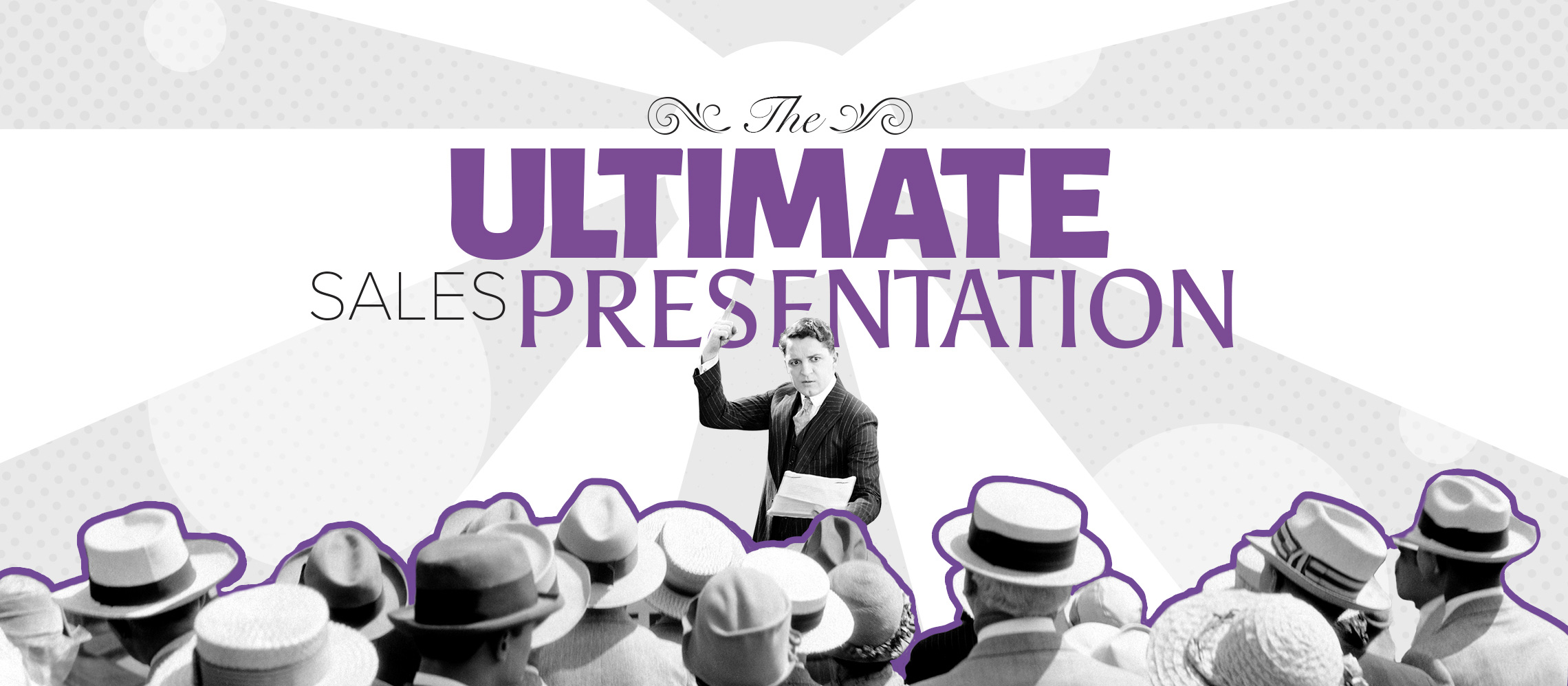So, you’re here because you want to create the perfect sales presentation? Well, you’ve found the web page with the secret formula for success. We’ve curated a one-stop resource for all things sales presentations. This guide covers all of the core components of the ultimate sales presentation, giving you the gift of knowledge in the hope that you’ll feel empowered to assemble an electrifying speech.
You’ll find every stepping stone on the journey to sales presentation perfection, right here in this guide. The magic elixir is hidden in these paragraphs and once you’ve absorbed the material, you’ll have the confidence to strut onto that stage, knowing that you’ve learned your craft from the some of the best source material out there.
This guide will give you abundant resources to help you prepare for the big day. Preparation is the antidote for most presentation-related anxieties. Nervous? Prepare to erase those nerves. Not confident in your material? Prepare to boost self-belief. Unsure what key messages you want to convey? Prepare by drilling down into the juiciest bits of your argument. As the saying goes, failure to prepare is preparing to fail, and we’ve not seen anything to dispute that notion yet.
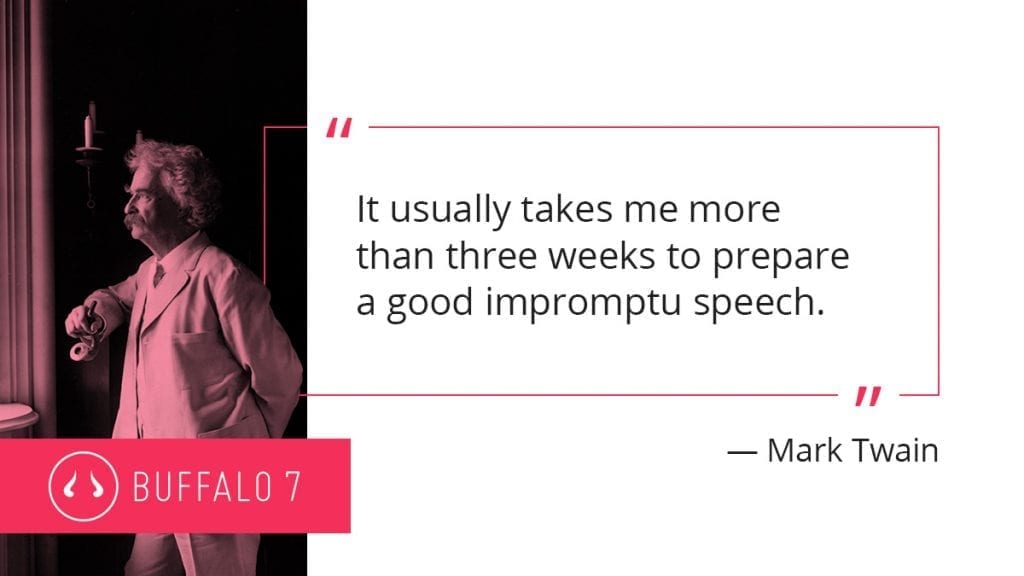
Tips for using the guide
If you’re serious about delivering the perfect sales presentation, we’d recommend going through the guide chronologically, so that you’re ticking off every important checkbox. However, if you’ve pinpointed your weaknesses and you’re here to focus on developing a particular area, you can use the menu system below to jump to the relevant topic.
Sales presentation menu
Storytelling – the content of your sales presentation
Slide design – the look of your sales presentation
PowerPoint development – adding motion to your sales presentation
Delivery – how to deliver your sales presentation
Storytelling for sales presentations
Define your messaging
Step one is all about identifying your key messages. What do you want the audience to know? What’s the purpose of your presentation? What are the reasons you’re reading this guide right now? I like to think of creating a new presentation as similar to building a new home. Before you can start on the fun visuals parts like the interior design, furniture selection, wall painting and art work, you need to lay the groundwork: the bricks, the cement and the structural pillars.

Your key messages are the pillars of your sales presentation. This foundation has to be put in place long before you meet with prospective clients. Before you contact leads, before you fire up PowerPoint, before you tell your manager, you’ve got to identify your reasons why. Let’s move onto some tips for defining your messaging.
Set yourself up as a problem solver
You should frame your key messages as a response to a problem that your target audience has. If you can set your ideas up as a problem-solving solution that will help their lives in some way, then you’re off to a flying start because you’ll grab their attention.
In business, people make purchasing decisions based on what they believe will solve their professional challenges. If you can acknowledge their challenges and identify their pain points, you’re much more likely to strike a chord with the audience and persuade them to put their trust in you. Position yourself as someone who can help. You’re the voice of reason. The Hermione, the Gandalf and the Yoda.

Take us as an example. We only exist because our founder recognised a need and devised a solid plan of how we could meet that need. He saw that businesses were struggling to create slick, impactful presentations that matched the quality of their brand, and knew how he could help. By combining storytelling, design and development into a package, businesses could have their entire presentations taken care of for them, without having to lift a finger themselves. And so, Buffalo 7 was born.
So, what lessons can you take from our inception? Well, it’s clear that burgeoning businesses have got to respond directly to a set of needs and appeal to peoples’ emotions. Are you saving them time? Are you reducing their stress? Are you making their day-to-day lives happier by eliminating a problem? Whatever it is that you’re bringing to the table, shout about it. Focus on selling the business benefits of the solution, not the features. You want to make it as easy to understand as possible: it has to be obvious how you’re going to help them, and they should leave your talk with a thorough understanding of what you can offer.
Frame your pitch with story elements
The worst kind of presenters are those who are there just to sell. Of course, this is one dimension to why you’re there, but it shouldn’t take centre stage. Think about how boring it would be for the audience if you just stood up to talk through the business benefits of your solution before ending with your contact details. Through this act of barefaced self-promotion, you’re not giving the audience anything of value.
Instead of selling your solution as a sales pitch plain for everyone to see, interlacing your business pitch with story elements will give you a much better chance of making a successful sale. Think about your audience: what they’re experiencing now, the obstacles they face, how those obstacles make them feel. Are there any real-life examples you can talk about? Can you introduce a relatable character? People are drawn to stories, they’re like brain food. So, if you adopt the build-up, conflict, resolution, climax hallmarks of a traditional story as a cloak for concealing your sales agenda, you’ll give yourself the upper hand.
Tailor your sales presentation to your audience
Once you’ve outlined your solution, you’ve got to think about how to tailor the delivery of that solution to a particular target audience. Immerse yourself in their industry, find out what it’s like to carry out their day-to-day activities and try to understand how it feels to encounter the obstacles they face.
When you can empathise with their experience, it’ll be much easier for you to develop sales messaging that appeals to individual audiences. Assess their needs, be confident in the aspects of your solution that can help them and tailor powerful, emotional messaging that appeals to a specific customer base.
Avoid an information overload
Slide cramming won’t do you any favours. If you’ve got paragraphs of text, back row dwellers may not be able to read it and your audience will be focused on reading the slides instead of listening to you.
It’s down to you to make sure your argument is as easy to follow as possible. Be concise and focused with your selection of what goes on the slides. When going through the cut or stay procedure, think about your copy in terms of necessity: if it’s not a necessary element of your pitch, it’s not necessary to display it. Generally, sticking to one argument per slide is a sensible formula.
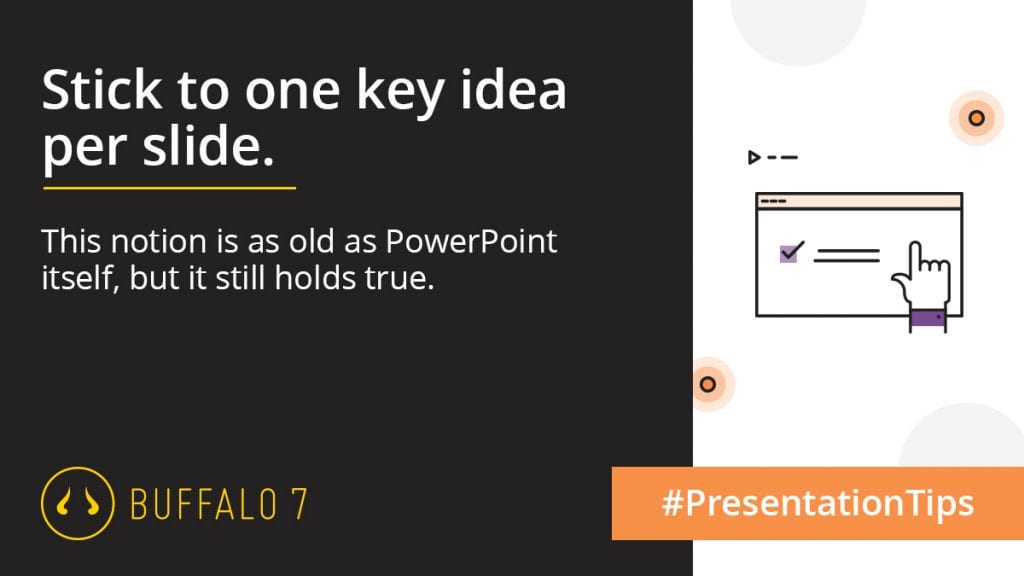
Be agile, flexible and prepared
Picture this. You develop a powerful sales presentation that has slick visuals and concise key messages. You arrive at a meeting, launch your deck but then something happens that you hadn’t planned for. The clients start pushing the conversation in other directions, asking questions you hadn’t expected, about topics you’re not prepared for.
Situations like this can catch you off guard, especially if you’ve built a linear presentation. Such presentations (those that are navigated chronologically), are rendered useless if clients start shaping the conversation in their own way. You should always try to stay customer-focused in your approach, so it’s important to prepare to deliver off the cuff. Try to anticipate what they could ask and make sure you know your stuff before going into the meeting.
To prevent all your hard work going to waste when faced with a more demanding client, consider building a non-linear PowerPoint navigation system. This type of navigation gives you more flexibility to move freely between topics of discussion. Instead of being stuck in the confines of a more structured presentation, you can stay agile and responsive to the environment you’re in.
Know your content like the back of your hand
You’ve probably heard this before but it’s important to hear it again. Knowing your content signals to that idiom we’ve all heard throughout our lives “Practice makes perfect”. Read your content regularly, quiz yourself as if you were an audience member and practice your delivery relentlessly. You always get out what you put in. The more you practice, the more confident you’ll feel and the more poised you’ll appear when facing an audience.
Remember to view your slides as a visual aid rather than the focus of the presentation. You shouldn’t depend on your slides, they’re there to enhance and support what you’re saying rather than serve as the focal point. It’s you who must arrest the audiences’ attention, you who has to deliver your messages and you who has to persuade them to buy into what you’re saying.
No one will believe in you if you don’t come across as an expert on it. It’s up to you to inspire confidence and belief in your ideas. If you truly know your stuff and believe in your ability to help people, you’ll speak with a natural knack that will boost your chances of getting follow up conversations. As a general rule when crafting your speaker notes, stick to simple, digestible, snappy and memorable statements that are easy to understand and recall. The purpose of knowing your content inside out is to deliver it in such an impactful way that the audience will come to know your content too.
Slide design for sales presentations
Without a strong visual aid to fall back on and enhance your words, your presentation can come across as quite static and mundane. The perfect sales presentation should fuse storytelling, design and animation together to create a transfixing pitch that speaks to peoples’ eyes and minds.
Harness the power of slide design
People presume that PowerPoint is limited as a software. True, there are a lot of bad PowerPoint presentations out there, but perhaps this is more a fault with how the program is used rather than the program itself. In our experience, PowerPoint has ticked all the boxes, but you can’t really design in PowerPoint without having some knowledge of design best practice.
If we created a list of death by PowerPoint criteria, text-heavy slides, bullet points and overcrowded slide design would be near the top. On slide copy should be minimal, leaving plenty of room for design to steal the show.
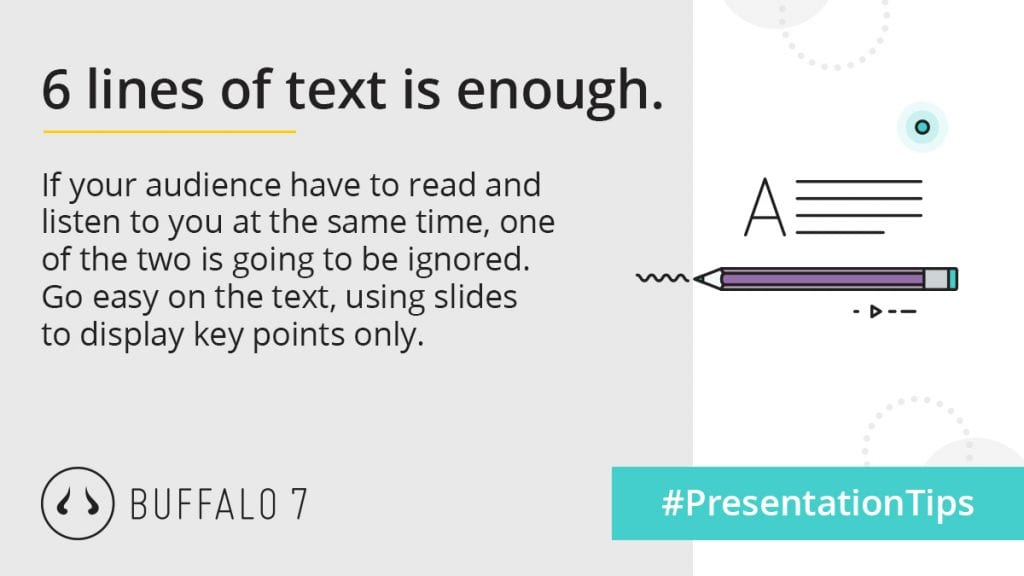
The best kind of design is used as a tool to visualise the points being made on the slide. Focus on using relevant imagery to accentuate the key bits of text or to shape what the audience focuses on. The right image selection can even help clarify complicated ideas and paint a more detailed picture of what you’re trying to say.
Intricate, well thought out design plays a star role in driving audience engagement and responsivity to your ideas. So long as your visuals reflect your brand, support your main ideas and help the audience envisage what you’re talking about, presentation design is a valuable and worthwhile tool to invest in.
PowerPoint development for sales presentations
When we say PowerPoint development, we’re talking about bringing your designs to life by adding motion in PowerPoint. This is where animation comes into play. Used to emphasise, detract and ensure seamless continuity, animation transforms standard presentations into powerful professional sales tools. Let’s take a look at how it can be used.
Silky smooth slide animation
This part’s optional but we’d recommend it if you want maximum impact. The perfect sales presentations should harness all three (storytelling, design and animation) of the core components of presentation design. Animation is the final flourish, the torching of the sugar in crème brûlée, the sprinkles on the donut.

Adding motion to your sales presentation brings more energy to the slides by enlivening static content with movement. The end result is the creation of a deck that flows smoothly from section to section. Animation makes presentations feel more professional and intuitive, but only when well executed. As school kids, we loved using those crazy animations where bullet points would fly on after doing three swirls and exploding. As adults, using this type of over the top animation could actually undermine the points you’re making, distract and even irritate the audience.
However, carefully-selected animation can encourage the audience concentrate on specific parts, help your ideas progress fluidly and introduce new ideas dramatically. Animation should feel free-flowing and natural, so there are a handful of rules to stick to whenever you animate. The first is consistency: if you’ve got 6 icons on a slide, it would look a little off if one of them had a different animation to the rest. You should also aim for subtlety to keep your audience focused on the message rather than the medium. Subtlety ties into moderation. Keep things interesting, not distracting – don’t feel as though you have to animate everything. Less is always more.
How to deliver your sales presentation
You’ve done the prep, now it’s time to work on your delivery. Presentation delivery is a multi-faceted trade that involves the blend of a range of coveted skills in the business world. It’s up to you to bring energy, enthusiasm and passion to the stage but we’ve got a few tips that will help you deliver in style and make a first impression that counts.
There are plenty of cultural maxims around first impressions. You never get a second chance at making a first impression, first impressions last forever, la dee da. We all know that the first few moments are critical for grabbing attention, gaining trust and boosting the potential for buy in. With so much hype surrounding that first interaction, it’s up to you to get it right. No pressure though, we’ll help you out.
Don’t dive in with an unapologetic sale
Launching straight into a sales pitch isn’t a very warm or inviting way to start a dialogue with someone, let alone someone who you want to buy from you. Your prospects care about themselves, their company and their own professional challenges. Bombarding them with product features, company information and isolated facts isn’t the best way to captivate their attention.
Instead, set aside some time before your presentation to chat about your customer’s needs in greater detail. Review the problems they’re facing and clarify the reasons why they may benefit from your ideas. These reasons should be the launch pad of your presentation. Acknowledge their plight and show them that you know what hardships they face. This will establish your credibility, lay the groundwork for brand trust and prick up their ears, getting you off to an auspicious start.
Save the apologies for later
Think about the world’s most renowned public speakers. Do they ever kick off their speech with an apology? Probably not. If people are listening to you speak, they don’t want to hear you undercut your own authority. Don’t apologise about a thing. They’re there to listen to you and you’re not there to give them reasons not to listen.
If you’re nervous and need to break through an imagined wall of tension in your mind, you can practice good onstage mental hygiene by preparing a few ice breakers. Open with an audience question, with an interesting stat, an emotive quote, or even a joke. The audience will take a joke over an apology, any day.
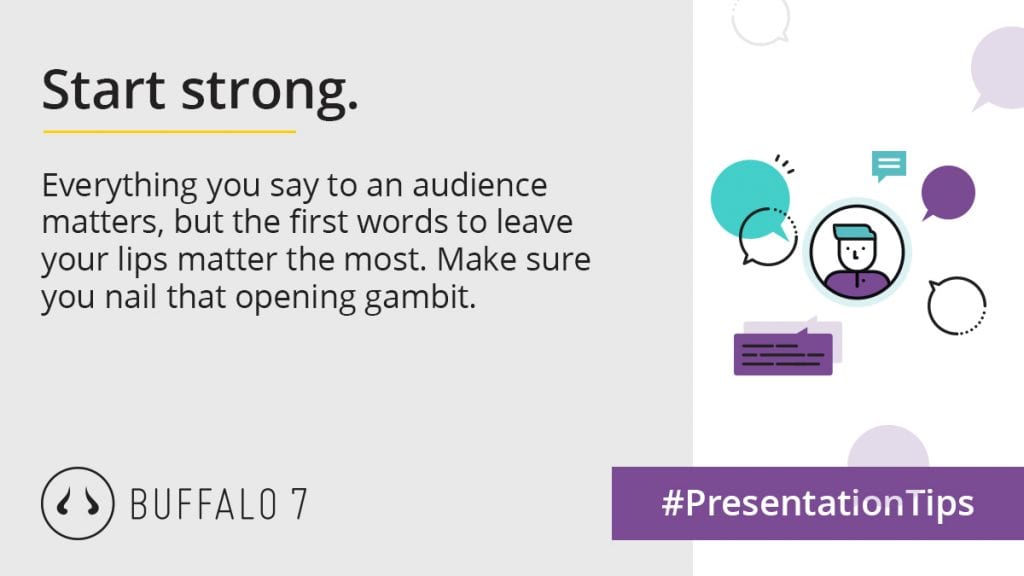
Funny or farcical?
Which brings us nicely onto our next point. Humour is a risky business. Get it wrong and you’re pretty much signing your own onstage death warrant. Get it right and you’ll get the audience on your side from the outset. Plan your jokes carefully and envisage the different ways it could be received. Run it past a few people to gauge their reaction before planning it in to your intro. If there’s potential for discomfort, play it safe by either thinking of a new joke or just scrapping the joke altogether.
Remove the potentiality for technical hurdles
Be more Marco Bielsa than Sam Allardyce – find out what resources and equipment facilities will be available to you before your presentation, and plan accordingly. Watching you fiddle with cables or trying desperately to get online is just plain boring for your audience and semi awks.
Once you’re in the room, you want to hook their attention from the get-go. Embed any video or interactivity into the presentation itself so you’re not at the mercy of a WIFI connection. Also, be sure to save your presentation as a .PPS, so that it opens in slideshow mode and you can get moving right away.
Hammer home the good bits
Remember when we told you to outline your key messages? These are the ideas you’ve got to hammer home. Use them as a focal point to ground your presentation. Frame your arguments around these thoughts and make sure that you’re evidencing your argument. If you can add weight to your ideas with real-life examples or statistics, you’ll fortify your argument with logic. If you find yourself digressing, bringing yourself back to those key messages will help you stick the original plan. Memorize those key points and they’ll ensure that your sales presentation is rooted in the strategy that you’ve worked on.
Welcome audience participation with open arms
Some businesses have a narcissism problem. When it comes to talking about themselves, they can’t resist a long credentials section that shouts about their achievements. Resist the temptation to talk about you and remember that it’s the product your prospect is interested in first and foremost.
Connect the dots from your messaging and examples back to their situation, letting them know that they’re the gravitational centre of your work. Opening the floor to audience participation is a great way of deflecting the attention away from you if you’re a little nervous and inviting the audience to directly engage with your ideas then and there. If they interact with you, they’re more likely to remember parts of your presentation, so see if you can stealthily weave one of your key messages into an audience interaction.
Clarify your next steps
To keep the audience on the road to conversion, make sure you know what you want them to do as soon as you’ve delivered your closing statement. Do you want them to contact you? Do you want to send them to a particular web page? Do you want them to think about a particular idea further? Whatever the next steps are, make sure they’re clear and simple. Some people judge the success of their talk by tallying up the number of people who perform your next steps.
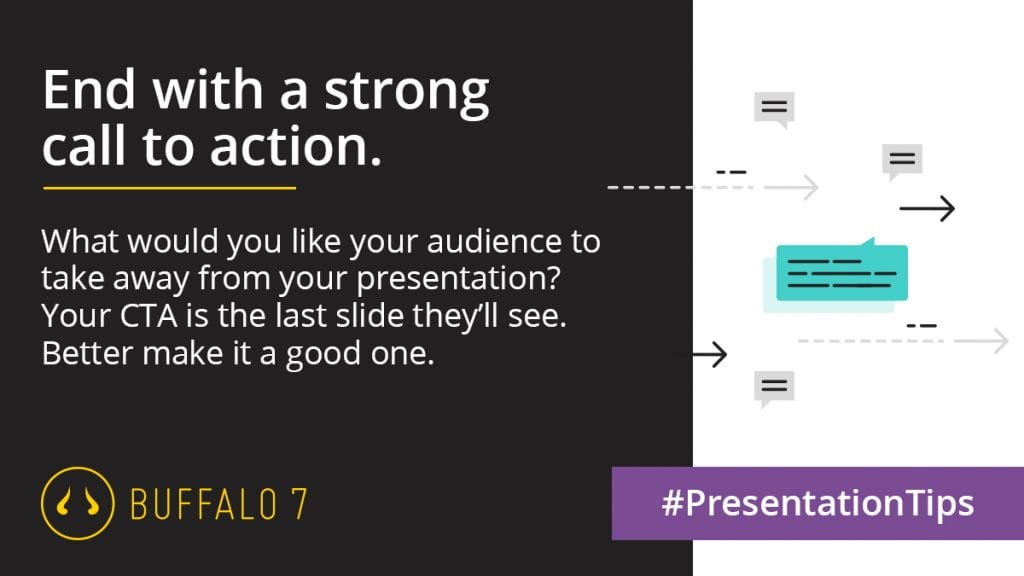
If you found this guide useful, we’ve got a wellspring of other presentation-related resources right here. We’ve been doing this presentation thing for a long time and we like to think we’ve seen and know it all. If you want us to fully take the reins, we can. If you need one of our experts to guide you through a particular stage of development, they can. If you need a refresh or a total overhaul, we’re the people you should talk to. So let’s talk.
